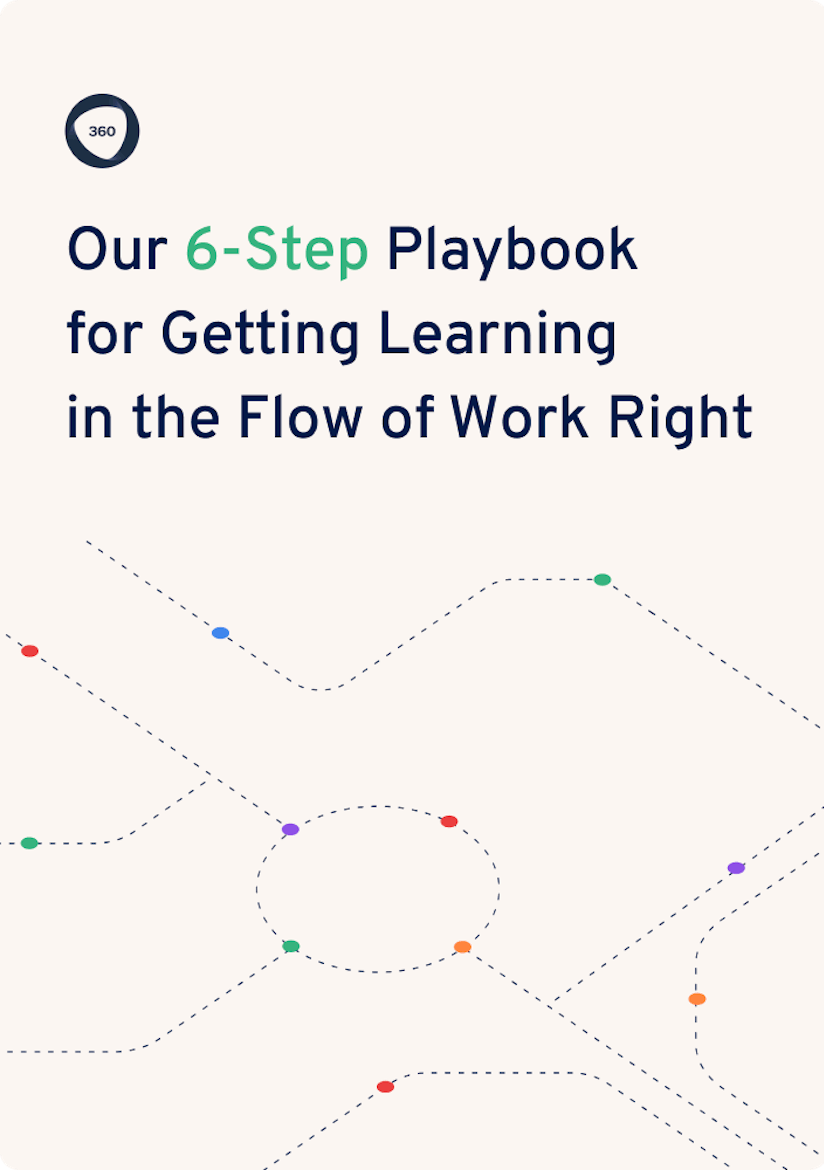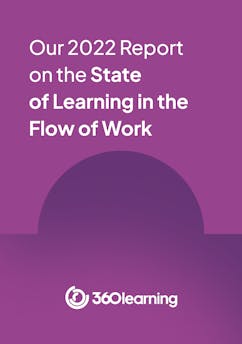Chapter 1: US Learners Are Motivated but Have No Time
How do employees prefer to learn in the workplace? What obstacles stand in their way? Do learning and development professionals understand these challenges? These were some of the questions we set out to answer with this report. Here, we’ve focused on the United States. We gathered our main insights regarding how learners and L&D leaders alike approach learning in the flow of work, and identified ways we can all improve.
The data in this chapter represents responses from 500 US employees (learners) and 252 US L&D decision-makers.
What motivates US employees to learn?
To understand what learners need, we first need to understand why they learn. So, what do the numbers tell us about what motivates people to learn?
Our survey suggests the majority of US employees see learning as a very pragmatic exercise; 75% say they pursue learning at work simply to do their jobs better. They also want to feel better at work, too. The second cited driver for engaging with continuous learning (66%) was, “to keep me motivated and confident at work.” This aligns nicely with the top reason why people managers recommend L&D programs to direct reports, which is to “improve skills for their roles.”
But this doesn’t mean employees are focused solely on the courses that will help them in the short term. In fact, employees are eager to take advantage of all possibilities—68% say they take advantage of every learning opportunity at their organization, versus 22% who say they only participate in trainings that are strictly related to their job, and 11% that only do mandatory training.
68% of respondents say they take advantage of every learning opportunity at their organization, versus 22% who say they only participate in trainings that are strictly related to their job, and 11% that only do mandatory training.
Similarly, when asked what’s stopping them from learning at work, the most frequent response (38%) from people was, “nothing, I’m learning a lot at work.” This is excellent news for L&D teams looking to transform their place of work into a true Learning Organization. However, that still leaves 62% of learners that are experiencing some type of roadblock that keeps them from maximum learning on the job.
Peer learning and in the flow of work learning; two all-star methods
For employees, not all learning methods are perceived as being equally effective–some generate much better outcomes than others.
Of all the types of training employees experience at work, “learning from peers” was considered by learners to be the most effective, with 64% of respondents saying it was “very effective” in helping them learn how to do their job. Coaching or mentoring was not far behind, at 61%.
At the other end of the spectrum, traditional “online learning (such as e-learning, virtual workshops, or MOOCs) recommended by my organization” were considered by only 38% of respondents to be very effective (though 49% found them somewhat effective). We could surmise here that peer-driven, one-to-one interactions are more useful for helping employees get their jobs done than top-down recommendations of traditional virtual learning.
Online learning (such as e-learning, virtual workshops, or MOOCs) recommended by my organization” were considered by only 38% of respondents to be very effective
Unsurprisingly, time was one of the major challenges cited when it comes to learning on the job. Here again, learners have a clear preference for how they can weave learning into their schedules. Instead of committing to a day of training once a year, or even blocking off a little time each day for eLearning, employees far prefer to “learn as they go, making the most of opportunities to speak with people and look things up for myself.”

The preferences for peer exchange and self-directed learning shine through here. We can also see that scheduled learning, even in small chunks, doesn’t work for most learners. Instead, they want to ‘learn as they go’, seeking solutions to issues organically, at the point of need.
Three blockers holding back US learners and L&D teams
US learners provided some encouraging responses regarding the ease of access to and efficacy of learning. The overwhelming majority (84%) of employees who switched roles, for instance, benefited from formal training, which virtually all (92%) were either satisfied or very satisfied with.
Similarly, employees find it reasonably easy to access learning at work, with the majority saying it’s “somewhat easy”:

But what would it take for the majority of learners to say it was “very easy” to access learning at work? After all, 87% of employees say that it’s likely they’d engage with even more learning at work if courses were easier to access than they are today.
We found three blockers L&D teams can address to improve the learning experience.
#1: Time crunch
Timing and scheduling stood out as the biggest blockers for learners. Over half of respondents said that what would help them take advantage of more work-related learning opportunities is if they could learn at work during working hours, or if their manager helped them offload some of their work. Similarly, for those who admitted something was stopping them from learning at work, they said it was because they had no time, and were too busy.
Unsurprisingly, this isn’t just a challenge for learners. On the L&D side, time and resources also stood out as their biggest challenge:

These points circle back to our earlier observation that employees embrace a peer-driven approach to learning. This is a boon for learners and L&D professionals alike, since methods such as collaborative learning, which rely on internal subject-matter experts for course creation and are founded on a decentralized, bottom-up approach, are big time-savers for L&D teams.
From the employee perspective, as long as course creators are supported with easy-to-use authoring tools, and especially if they’re building short and easy-to-consume courses (micro-learning), engaging in collaborative learning won’t put a strain on their schedule.
#2: Course relevance
Another way L&D professionals can take their training efforts from good to great is by making course material even more relevant and specific to learner needs. When it comes to manager training, for instance, 41% of new managers said that the training they received was too generic and not specific to the situations they faced in their role as a manager.
Part of this issue may lie in how L&D teams source learning needs. The majority (48%) of our respondents said they identify learning needs during performance reviews, which might only be once yearly, and a shocking 12% said they didn’t identify learning needs at all. If learning needs aren’t identified frequently enough, it’s difficult for L&D professionals to address them effectively.
Coming back to manager training, 30% also said that their training didn’t come at the right time, saying it came either too early or too late. A third also would have liked their training to have been longer.
L&D professionals seem to be aware that planning for manager training may not always fit nicely into everyone’s schedules. While 28% of L&D professionals say their new manager training is continuous, 20% say new manager training comes in when there is availability on a management program or when the new managers are available to attend. This again highlights the persistent problem of timing in ensuring training is delivered right at the point of need, where it can be most effective.

#3: Technical limitations
Employees express enthusiasm for in the flow of work learning and peer-driven learning, and cite time constraints and generic courses as their major obstacles. One excellent way to facilitate learning in the flow of work (which by definition doesn’t interrupt an employee’s routine or take them away from their main tasks) is through technical integrations.
When an employee can receive targeted training recommendations based on their workflow, or reminders about courses without having to leave their usual interface, it makes it that much easier for them to engage with learning. Instead of having a hundred open tabs or needing to block off dedicated time for learning, they can smoothly transition from work to course material and back again.
However, nearly half of L&D professionals either don’t know if their LMS can support these types of integrations, or are sure they can’t:

This is one area of opportunity L&D professionals can explore to close the expectation gap and go from providing good learning experiences, to providing great ones.
Make learning in the flow of work a top priority
Overall, L&D professionals have learning in the flow of work initiatives on their radar. Most (75%), for instance, feel they’re already effective at providing training at the point of need.

Although these numbers are encouraging, that still leaves a quarter of L&D teams unsure about their ability to deliver on learning in the flow of work, not to mention the challenges of scheduling and relevancy cited earlier by learners.
With this in mind, it’s interesting to note that learning in the flow of work seems to be attributed a middling level of importance by most L&D teams. Most, for instance, give it the same priority now as they did a year ago (62%), with 44% saying that today, it’s a ‘medium’ priority.


Considering how much of a preference learners have for learning in the flow of work, and how much time is an issue in accessing learning, there seems to be a bigger opportunity for L&D teams to shift learning in the flow of work from a medium priority to a top one.
Whether through looking into the possibility of useful integrations, providing training at the point of need, or collecting learning needs on a continuous, bottom-up basis, there’s still room for US learning and development professionals to prove their impact on business-critical metrics by closing the modest training satisfaction gaps that exist.
Considering how much of a preference learners have for learning in the flow of work, and how much time is an issue in accessing learning, there seems to be a bigger opportunity for L&D teams to shift learning in the flow of work from a medium priority to a top one.
Recommendations:
Here are some ways that L&D leaders in the United States can address these gaps and realize the potential of learning in the flow of work:
- Evangelize and utilize integrations that facilitate learning in the flow of work. Investigate how your LMS integrates with your learners’ top tools and interfaces.
- Source learning needs on a continuous basis. Closing the course relevance satisfaction gap and taking your programs from good to great means sourcing learning needs on a rolling basis.
- Ramp up peer-driven initiatives like coaching or mentoring. Learners prefer to learn from their colleagues. Explore how you can develop this kind of collaborative, peer-driven learning.
Make learning in the flow of work a top priority. Overall, don’t underestimate the potential of a strong learning in the flow of work program.
For more practical recommendations on getting learning in the flow of work right, check out our six-step playbook. You’ll learn:
- What mistakes to avoid
- Why uncovering evergreen problems and critical points of failure using data is the first thing you should do
- How to understand your learners better
- How to leverage subject-matter experts to facilitate learning in the flow of work
- What types of resources work best for flow of work

Practical, hands-on learning in 6 simple steps
By providing your contact info, you agree to receive communications from 360Learning. You can opt-out at any time. For details, refer to our Privacy Policy.


